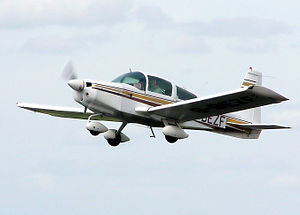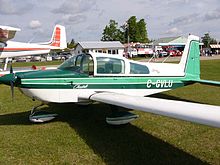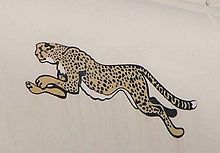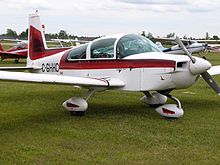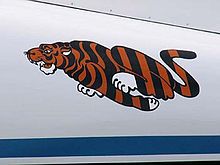- Grumman American AA-5
-
AA-5/AG-5 Aircraft Series Grumman American AA-5 Traveller Role Four-seat cabin monoplane National origin United States Manufacturer American Aviation
Grumman American
Gulfstream American
American General Aviation Corporation
Tiger AircraftFirst flight 1971 Introduction 1971 Produced 1971-2006 Number built 3,282 The US Grumman American AA-5 series is a family of all-metal, 4-seat, light aircraft used for touring and training. The line includes the original American Aviation AA-5 Traveler, the Grumman American AA-5 Traveler, AA-5A Cheetah, and AA-5B Tiger, the Gulfstream American AA-5A Cheetah, and AA-5B Tiger, the American General AG-5B Tiger, and the Tiger Aircraft AG-5B Tiger.
Contents
Development
Following American Aviation's success with the AA-1 Yankee Clipper two place light aircraft in 1969, the company decided to produce a four-seat aircraft. They started with a new "clean-sheet" design that was designated the American Aviation AA-2 Patriot. The AA-2 design did not meet its performance goals during test-flying and only one was ever built.
Still needing a four-seat aircraft to fill its product line, the company simply enlarged the external and cabin dimensions of the AA-1 Yankee to create the four-seater. This decision capitalized on the marketplace identification of the Yankee and its derivative the AA-1A Trainer and also resulted in 2/3 parts commonality between the designs, saving development time and production costs.
AA-5 Traveler
The new four-place aircraft, named the American Aviation AA-5 Traveler, was powered by a Lycoming O-320-E2G engine of 150 hp (110 kW). It would carry four people at 121 knots (224 km/h) cruise speed and was certified under US FAR Part 23.
Production of the Traveler had just started in 1971 when American Aviation was sold to Grumman and became the Grumman American division. Grumman continued production of the Traveler. 834 Travelers had been produced when production of this model ceased in 1975.
A redesign of the AA-5 was undertaken in 1974 and as a result the 1975 model Traveler featured an aerodynamic clean-up of the engine cowling and main gear fairings. The tail section remained unchanged. As a result of these changes the 1975 Traveler had a cruise speed of 127 knots (235 km/h). The Traveler was superseded in production the following year by the further refined AA-5A Cheetah.
AA-5A Cheetah
Grumman's engineers felt the AA-5 design had more speed potential than the original Traveler, even with its 1975 improvements, and so embarked on an aerodynamic cleanup and redesign. Changes were made to the engine cowling and baffling to reduce cooling drag, the exhaust system was redesigned, the main gear fairings were further improved, the ventral fin was deleted and the horizontal tail was enlarged to allow a larger center of gravity range. Fuel capacity was increased from the Traveler's 37 US gallons to 52 gallons, thus increasing its range.
The new variant was named the AA-5A Cheetah and was introduced as a 1976 model in late 1975. In keeping with its namesake it was 6 knots (7 mph) faster than the Traveler on the same 150 hp (110 kW) Lycoming O-320-E2G powerplant. Because the Cheetah looked very much like the Traveler externally, Grumman’s marketing department created a "leaping cheetah" emblem to differentiate it from the earlier AA-5.
Grumman sold its light aircraft division to Gulfstream Aerospace in 1978 and the division was renamed Gulfstream American. Gulfstream continued production of the AA-5A until 1979. A total of 900 Cheetahs were produced.
AA-5B Tiger
The final variant of the AA-5 line is the AA-5B Tiger. The Tiger was designed by Grumman engineers and was first produced in late 1974 as the 1975 model.
The Tiger was the outcome of the same redesign work on the AA-5 Traveler that resulted in the 150 hp (110 kW) Cheetah and it was originally little more than the same aircraft with a Lycoming O-360-A4K 180 hp (130 kW) engine, resulting in a 139-knot (257 km/h) cruise speed. Gross weight was increased from the AA-5/AA-5A's 2,200 lb (1,000 kg) to 2,400 lb (1,100 kg) on the Tiger. Externally the Tiger looked much like the AA-5 Traveler and AA-5A Cheetah so once again Grumman’s marketing department came up with a distinctive decal package to differentiate the design – this time a "galloping tiger".
While the earlier AA-1s and AA-5s did not change much from year to year the AA-5B Tiger underwent almost continual improvement. As with the AA-5A, the AA-5B was continued in production by Gulfstream when they purchased Grumman's American division. Gulfstream ceased production of all piston-engined aircraft in 1979 and the highly successful Tiger design went out of production after 1323 aircraft had been delivered.
AG-5B Tiger
For eleven years the design was not produced and then in the late 1980s a new company was formed to produce the Tiger. American General Aviation Corporation carried out further design improvements including introducing a new split nose bowl (engine cover) that could be removed without removing the propeller, a new instrument panel and improved exterior lighting, a new fuel quantity indication system, a 28 volt electrical system replacing the older 14 volt system, a new style throttle quadrant and improvements to the heat and ventilation systems. Aerodynamic improvements raised the optimal altitude cruise speed from 139 knots (257 km/h) true airspeed to 143 knots (265 km/h) TAS. The redesigned aircraft was put into production under an amended type certificate as the American General AG-5B Tiger. The new company had considered producing AA-1s and AA-5A Cheetahs, but those plans were never fulfilled before it closed its doors in 1993. American General produced Tigers for model years 1990-93 and delivered 181 aircraft in that time.
The design has a strong following among pilots and aircraft owners and so, in 1999, a new company was formed to put the Tiger back into production. Tiger Aircraft started production of the AG-5B Tiger in 2001 at their plant in Martinsburg, West Virginia. Tiger Aircraft did not produce any other models of the AA-1 or AA-5 family, although they owned the type certificates for the complete line of aircraft. Between 2001 and 2006 Tiger Aircraft produced 51 AG-5Bs. By the middle of 2006 Tiger Aircraft was experiencing financial problems and production of AG-5Bs had been halted and production workers laid off. [1][2] Tiger Aircraft filed for bankruptcy in January 2007.[3]
On August 2, 2007 The Federal Bankruptcy Court approved the sale of Tiger Aircraft assets to True Flight Holdings LLC. True Flight has indicated its intention to produce parts and also return the AG-5B Tiger to production as soon as possible at a planned 60,000-square-foot (5,600 m2) facility on a 13-acre (53,000 m2) lot at the Valdosta, Georgia Airport.[4][5][6]
If True Flight Holdings does put the Tiger into production, they will be the fifth manufacturer to do so.
AA-5 & AG-5 production
All told a total of 3,282 AA-5s and AG-5s was produced by the five manufacturers between 1971 and the end of 2005.
Construction
All models of the AA-5 have four seats under a sliding canopy, which can be partly opened in flight for ventilation. Entry for all four occupants is from the wing root over the canopy sill. Compared to competitive aircraft of the same era the AA-5s are noted for their light and pleasant handling characteristics as well as high cruising speed for the installed power.
As derivatives of the original AA-1 Yankee, the AA-5 series share the same unique bonded aluminum honeycomb wing and fuselage that eliminates the need for rivets without sacrificing strength. The main landing gear is fibreglass with a sprung steel nose gear tube. There is no nose wheel steering as the nose wheel is free-castering through 180 degrees. Steering is by main wheel differential braking operated by using one's toes to push the tops of the rudder pedals.
Variants
- AA-5 Traveler
- 1971 four-seat version of the AA-1 with a 150 hp (110 kW) Lycoming O-320-A2G engine, 821 built.
- AA-5A Cheetah
- 1975 variant with larger fin fillet and no ventral fin fairing, re-designed engine cowling and longer rear windows, 900 built.
- AA-5B Tiger
- 1974 variant with a 180 hp (130 kW) Lycoming O-360-A4K engine and increased take-off weight, 1323 built.
- AA-5C
- One prototype only.
- AG-5B Tiger
- 1990 variant of the AA-5B produced by American General Aviation Corporation and Tiger Aircraft
Specifications (2005 model Tiger Aircraft AG-5B Tiger)
Data from Tiger Aircraft[7]
General characteristics
- Crew: one, pilot
- Capacity: 3 passengers
- Length: 22 ft 0 in (6.7 m)
- Wingspan: 31 ft 6 in (9.6 m)
- Height: 8 ft 0 in (2.4 m)
- Wing area: 140 ft² (13 m²)
- Empty weight: 1,500 lb (680 kg)
- Loaded weight: 2,400 lb (1090 kg)
- Max takeoff weight: 2,400 lb (1090 kg)
- Powerplant: 1 × Lycoming O-360-A4K air-cooled, 4-cylinder, horizontally-opposed piston engine, 180 hp (134 kW)
Performance
- Maximum speed: 143 knots (163 mph, 265 km/h)
- Range: 686 nm (789 mi, 1,270 km)
- Service ceiling: 13,800 ft (4,200 m)
- Rate of climb: 850 ft/min (259 m/min)
- Wing loading: 17.1 lb/ft² (83 kg/m²)
- Power/mass: 0.08 hp/lb (0.12 kW/kg)
See also
- Related development
- Aircraft of comparable role, configuration and era
- Vans RV-10
- Cessna 182
- Piper Arrow
- Piper PA-28 Cherokee
- Beechcraft Musketeer
References
- ^ AvWeb Article May 31, 2006 Tiger Aircraft Seeking Cash By Mary Grady , Newswriter, Editor
- ^ AvWeb Article November 13, 2006 Tiger On The Ropes?
- ^ AvWeb Article January 21, 2007 $1 Million Debt Too Much For Aircraft Manufacturer? By Russ Niles, Contributing Editor
- ^ True Flight (November 1, 2007). "Renowned small aircraft manufacturer to locate in Valdosta". http://www.trueflightaerospace.com/. Retrieved 2007-11-03.
- ^ An Open Letter to the AYA By Kevin Lancaster, The American Star, The Official Publication of the American Yankee Association, Volume XXXII Number 5, September/October 2007 pg 4
- ^ American Yankee Association Homepage lead story accessed 19 September 2007
- ^ Tiger Aircraft (2002). "Specifications". Archived from the original on 2003-02-04. http://web.archive.org/web/20030204020154/http://tigeraircraft.com/spec.htm. Retrieved 2009-11-01.
- Aviation Consumer Used Airplane Guide 1989 Article - Gulfstream Tiger/Cheetah AA-5B/A
- Grumman Gang AA-5 Specifications and production numbers
- AG-5B Production update
- A16EA Type Certificate
External links
American Aviation light aircraft Aircraft Companies Lists relating to aviation General Aircraft (manufacturers) · Aircraft engines (manufacturers) · Airlines (defunct) · Airports · Civil authorities · Museums · Registration prefixes · Rotorcraft (manufacturers) · TimelineMilitary Accidents/incidents Records Categories:- Propeller aircraft
- United States civil utility aircraft 1970–1979
- Low wing aircraft
- Single-engine aircraft
Wikimedia Foundation. 2010.

